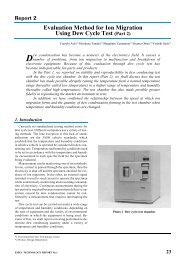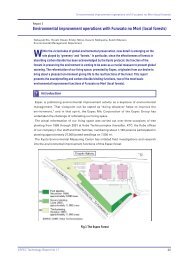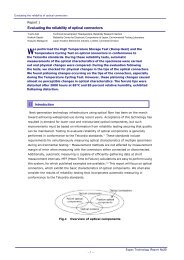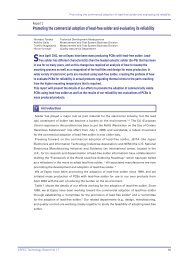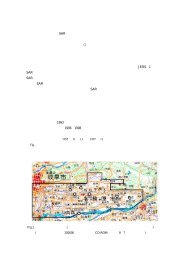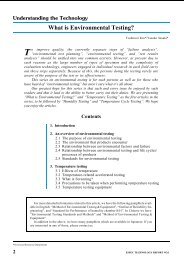Measuring conductivity of proton conductive membranes in the ...
Measuring conductivity of proton conductive membranes in the ...
Measuring conductivity of proton conductive membranes in the ...
Create successful ePaper yourself
Turn your PDF publications into a flip-book with our unique Google optimized e-Paper software.
<strong>Measur<strong>in</strong>g</strong> <strong>conductivity</strong> <strong>of</strong> <strong>proton</strong> <strong>conductive</strong> <strong>membranes</strong> <strong>in</strong> <strong>the</strong> direction <strong>of</strong> thickness<br />
Measurements were taken at an ambient temperature <strong>of</strong> 80°C us<strong>in</strong>g 4 types <strong>of</strong><br />
electrodes made <strong>of</strong> gold, plat<strong>in</strong>um, plat<strong>in</strong>um black and carbon paper. Fig. 4 shows <strong>the</strong><br />
humidity dependency <strong>of</strong> Rbulk (membrane resistance), R1, Y1, R2, and Y2 us<strong>in</strong>g <strong>the</strong> various<br />
electrode materials.<br />
As ambient relative humidity dur<strong>in</strong>g measur<strong>in</strong>g <strong>in</strong>creased, Rbulk, R1, and R2 decreased.<br />
This phenomenon <strong>in</strong>dicates that <strong>the</strong> <strong>conductivity</strong> <strong>of</strong> <strong>proton</strong>-<strong>conductive</strong> polymer materials<br />
such as Nafion ® depend on <strong>the</strong>ir water content. In particular, m<strong>in</strong>imum resistance was<br />
obta<strong>in</strong>ed for R1 and R2 when us<strong>in</strong>g <strong>the</strong> plat<strong>in</strong>um black electrode with higher active<br />
surface area, suggest<strong>in</strong>g that both loop 1 and loop 2 with R/Y parallel connections are<br />
strongly correlated to <strong>the</strong> <strong>in</strong>terface between membrane and electrode. With capacitance<br />
components <strong>of</strong> Y1 and Y2, regular <strong>in</strong>creases <strong>in</strong> electrical capacity were found to<br />
correspond to <strong>in</strong>creases <strong>in</strong> ambient humidity. Increases <strong>in</strong> this electrical capacity can be<br />
considered to result from improved contact between membrane and electrode concurrent<br />
to <strong>the</strong> hygroscopic swell<strong>in</strong>g <strong>of</strong> <strong>the</strong> moisture-absorbent membrane. Types and surface<br />
morphology <strong>of</strong> electrode materials also notably affect <strong>in</strong>terface resistance and capacity<br />
due to <strong>the</strong>ir varied surface area and differences <strong>in</strong> membrane contact. However, with Rbulk<br />
membrane resistance, equivalent measurement values have been obta<strong>in</strong>ed for various<br />
electrode materials with no major <strong>in</strong>fluence based on material types found. Therefore, it<br />
can be concluded that membrane resistance (Rbulk) can be separated from <strong>in</strong>terface<br />
elements (R1, Y1, R2, and Y2) regardless <strong>of</strong> electrode materials used, s<strong>in</strong>ce <strong>the</strong><br />
multi-layer complexity <strong>of</strong> contact <strong>of</strong> <strong>the</strong> <strong>in</strong>terface between membrane and electrodes,<br />
e.g., multiple semicircles <strong>in</strong> Cole-Cole plot, can be removed by equivalent circuit fitt<strong>in</strong>g.<br />
- 17 -<br />
Espec Technology Report No20



